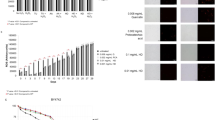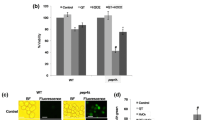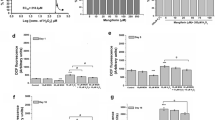Abstract
Aging is known to associate with inflammation that accelerates aging process. The anti-aging activity and the related inflammatory mechanisms of kimchi during fermentation were evaluated using stress-induced premature senescence (SIPS) of WI-38 human fibroblasts caused by hydrogen peroxide (H2O2), a well established cellular aging model. The methanol extracts of fresh kimchi (pH 5.8), optimally ripened kimchi (OptR kimchi, pH 4.1), and over ripened kimchi (pH 3.8) fermented at 5°C were prepared. H2O2-treated WI-38 cells showed the loss of cell viability, the increase of lipid peroxidation and shortening of the cell lifespan, indicating the induction of SIPS. However, the treatment of kimchi, especially OptR kimchi, attenuated cellular oxidative stress through increase in cell viability and inhibition of lipid peroxidation. In addition, the lifespan of young-, middle-, and old-aged WI-38 cell was extended, suggesting promising role of kimchi as an anti-aging agent. Furthermore, H2O2-treated WI-38 cells significantly increased the age-related inflammatory gene expression such as nuclear factor-κB (NF-κB), cyclooxygenase-2, inducible nitric oxide synthase. However, the treatment of kimchi exerted anti-aging effect through NF-κB-related gene regulation. These results suggest that kimchi, especially OptR kimchi, may delay the aging process by regulation of inflammatory process.
Similar content being viewed by others
References
Harman D. Free radical theory of aging. Mutat. Res. 275: 257–266 (1992)
Ashok BT, Ali R. The aging paradox: Free radical theory of aging. Exp. Gerontol. 34: 293–303 (1999)
Valko M, Leibfritz D, Moncol J, Cronin MTD, Mazur M, Telser J. Free radicals and antioxidants in normal physiological functions and human disease. Int. J. Biochem. Cell B. 39: 44–84 (2007)
Bokov A, Chaudhuri A, Richardson A. The role of oxidative damage and stress in aging. Mech. Ageing Dev. 125: 811–826 (2004)
Hayflick L, Moorhead PS. The serial cultivation of human diploid cell strains. Exp. Cell Res. 25: 585–621 (1961)
Toussaint O, Remacle J, Dierick JF, Pascal T, Frippiat C, Zdanov S, Magalhaes JP, Royer V, Chainiaux F. From the Hayflick mosaic to the mosaics of ageing. Role of stress-induced premature senescence in human ageing. Int. J. Biochem. Cell B. 34: 1415–1429 (2002)
Toussaint O, Medrano EE, von Zglinicki T. Cellular and molecular mechanisms of stress-induced premature senescence (SIPS) of human diploid fibroblasts and melanocytes. Exp. Gerontol. 35: 927–945 (2000)
Park KY, Rhee SH. Functional foods from fermented vegetable products: Kimchi (Korean fermented vegetables and functionality). pp. 341–380. In: Asian Functional Foods. Shi J, Ho CT, Shahidi F (eds). CRC Press, Inc., Boca Raton, FL, USA (2005)
Cho EJ, Rhee SH, Park KY. Studies on the standardization of Chinese cabbage kimchi. Korean J. Food Sci. Technol. 30: 324–332 (1998)
Cristofalo VJ, Charpentier R. A standard procedure for cultivating human diploid fibroblastlike cells to study cellular aging. J. Tiss. Cult. Meth. 6: 117–121 (1980)
Yagi K. A simple fluorometric assay for lipoperoxide in blood plasma. Biochem. Med. 15: 212–216 (1976)
Yokode M, Kita T, Kikawa Y, Ogorochi T, Narumiya S, Kawai C. Stimulated arachidonate metabolism during foam cell transformation of mouse peritoneal macrophages with oxidized low density lipoprotein. J. Clin. Invest. 81: 720–729 (1988)
Biesalski HK. Free radical theory of aging. Curr. Opin. Clin. Nutr. 5: 5–10 (2002)
Harman D. The free radical theory of aging: Effect of age on serum copper levels. J. Gerontol. 20: 151–153 (1965)
Harman D. Free radical theory of aging: Dietary implications. Am. J. Clin. Nutr. 25: 839–843 (1972)
Harman D. Nutritional implications of the free-radical theory of aging. J. Am. Coll. Nutr. 1: 27–34 (1982)
Harman D. The free radical theory of aging. Antioxid. Redox Sign. 5: 557–561 (2003)
Choi AM, Pignolo RJ, apRhys CM, Cristofalo VJ, Holbrook NJ. Alterations in the molecular response to DNA damage during cellular aging of cultured fibroblasts: Reduced AP-1 activation and collagenase gene expression. J. Cell. Physiol. 164: 65–73 (1995)
Cristofalo VJ. Cellular biomarkers of aging. Exp. Gerontol. 23: 297–307 (1988)
Satoh A, Yokozawa T, Cho EJ, Okamoto T, Sei Y. Antioxidative effects related to the potential anti-aging properties of the Chinese prescription Kangen-karyu and Carthami Flos in senescenceaccelerated mice. Arch. Gerontol. Geriat. 39: 69–82 (2004)
Wolf FI, Torsello A, Covacci V, Fasanella S, Montanari M, Boninsegna A, Cittadini A. Oxidative DNA damage as a marker of aging in WI-38 human fibroblasts. Exp. Gerontol. 37: 647–656 (2002)
Choi MJ, Kim BK, Park KY, Yokozawa T, Song YO, Cho EJ. Antiaging effects of cyanidin under a stress-induced premature senescence cellular system. Biol. Pharm. Bull. 33: 421–426 (2010)
Satoh A, Yokozawa T, Kim YA, Cho EJ, Okamoto T, Sei Y. The mechanisms underlying the anti-aging activity of the Chinese prescription Kangen-karyu in hydrogen peroxide-induced human fibroblasts. J. Pharm. Pharmacol. 57: 1335–1343 (2005)
Aktan F. iNOS-mediated nitric oxide production and its regulation. Life Sci. 75: 639–653 (2004)
Ahmed EK, Picot CR, Bulteau AL, Friguet B. Protein oxidative modifications and replicative senescence of WI-38 human embryonic fibroblasts. Ann. NY Acad. Sci. 1119: 88–96 (2007)
Schreck R, Albermann K, Baeuerle PA. Nuclear factor κB: An oxidative stress-responsive transcription factor of eukaryotic cells (a review). Free Radical Res. Com. 17: 221–237 (1992)
Biswas SK, Lopes de Faria JB. Does peroxynitrite sustain nuclear factor-κB? Cardiovasc. Res. 67: 745–746 (2005)
Baeuerle PA, Baltimore D. NF-κB: Ten years after. Cell 87: 13–20 (1996)
Dumont P, Balbeur L, Remacle J, Toussaint O. Appearance of biomarkers of in vitro ageing after successive stimulation of WI-38 fibroblasts with IL-1α and TNF-α: Senescence associated β-galactosidase activity and morphotype transition. J. Anal. 197: 529–537 (2000)
Cho EJ, Okamoto T, Yokozawa T. Therapeutic efficacy of Kangenkaryu against H2O2-induced premature senescence. J. Pharm. Pharmacol. 60: 1537–1544 (2008)
Author information
Authors and Affiliations
Corresponding author
Rights and permissions
About this article
Cite this article
Kim, B., Park, K.Y., Kim, H.Y. et al. Anti-aging effects and mechanisms of kimchi during fermentation under stress-induced premature senescence cellular system. Food Sci Biotechnol 20, 643–649 (2011). https://doi.org/10.1007/s10068-011-0091-9
Received:
Revised:
Accepted:
Published:
Issue Date:
DOI: https://doi.org/10.1007/s10068-011-0091-9




